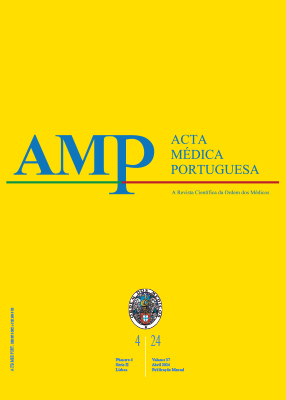Trauma Injuries Associated with Rope Bullfights in the Azores: A Cross-Sectional Study
DOI:
https://doi.org/10.20344/amp.19440Keywords:
Multiple Trauma, Severity of Illness Index, Wounds and Injuries, Wounds, NonpenetratingAbstract
Introduction: The aim of the study was to describe trauma injuries associated with rope bullfights in the Azores, Portugal, regarding the cause of the incident, trauma mechanism, most affected anatomical areas, and injury severity.
Methods: Two-year cross-sectional study in the local hospital with prospective data collection. Patients who were consecutively admitted to the local hospital’s emergency department with trauma injuries from the bull’s direct impact or from falls either during the bull’s escape or when handling the rope, were included. Data on general demographics, lesion characteristics, treatments, need for hospitalization and mortality were collected.
Results: Fifty-six incidents and 80 trauma injuries were identified. The main cause of trauma was the bull’s direct impact (37; 66.07%) and the mechanism of injury was blunt trauma in all patients (100%; 56). Head and neck injuries (27; 33.75%) were the most common. The median Injury Severity Score at the emergency department admission was 4. Major trauma was noted in five patients (8.92%). Ten patients (17.85%) needed hospitalization with a median hospital stay of seven days. Three of the 10 hospitalized patients (30%) were previously admitted to the intensive care unit. Surgery was performed in six patients (10.71%).
Conclusion: The main cause of trauma was the bull’s direct impact, and the mechanism of injury was blunt trauma. The most affected anatomical areas were the head and neck. These findings are a wake-up call to the impact of these events regarding the economic costs they entail, the costs for the health of the local population, the safety measures currently implemented and the availability of the necessary means to treat these patients.
Downloads
References
Nagarajan S, Jena NN, Davey K, Douglas K, Smith J, Blanchard J. Patients presenting with bull-related injuries to a southern indian emergency department. West J Emerg Med. 2020;21:291-4. DOI: https://doi.org/10.5811/westjem.2020.5.47212
Reguera-Teba A, Martínez-Casas I, Torné-Poyatos P, Hernández-Cortés P. Eight-year analysis of bullfighting injuries in Spain, Portugal and southern France. Sci Rep. 2021;11:16006. DOI: https://doi.org/10.1038/s41598-021-94524-7
Rudloff U, Gonzalez V, Fernandez E, Holguin E, Rubio G, Lomelin J, et al. Chirurgica taurina: a 10-year experience of bullfight injuries. J Trauma. 2006;61:970-4.
Durão C, Ramos J. Flagrante de uma fratura da clavícula por acidente. Acta Med Port. 2016;29:758-60. DOI: https://doi.org/10.20344/amp.8320
Başbuğ HZ, Göçer H, Günerhan Y, Özışık K. An isolated femoral vein injury caused by bull horn. EJCM. 2018;6:27-31. DOI: https://doi.org/10.15511/ejcm.18.00127
Navas-Mosqueda Á, Valera-Calero JA, Varol U, Klich S, Navarro-Santana MJ, Fernández-de-Las-Peñas C, et al. The prevalence of shoulder disorders among professional bullfighters: a cross-sectional ultrasonography study. Tomography. 2022;8:1726-34. DOI: https://doi.org/10.3390/tomography8040145
Crespo Escudero JL, Arena Búa J, Luaces Rey R, García-Rozado A, Rey Biel J, López-Cedrún JL, et al. Herida por asta de toro en el área maxilofacial: revisión de la literatura y presentación de un caso. Rev Esp Cir Oral Maxilofac. 2008:30:353-62. DOI: https://doi.org/10.4321/S1130-05582008000500007
Priyadarshi V, Gupta D, Pal DK. Lower genitourinary tract trauma caused by cow horn injury. JOGI. 2016;66:578-82. DOI: https://doi.org/10.1007/s13224-015-0748-z
Hariharan U, Arora R, Kumar Nishad A, Sood R. Horn injury to chest – management and review of literature. JACCOA. 2017;8:00305. DOI: https://doi.org/10.15406/jaccoa.2017.08.00305
Singh KD, Singh V, Gupta P, Mani R. A rare case of bullhorn-injury associated traumatic hernia of anterior abdominal wall managed by laparoscopic sutured tissue-only repair. J Postgrad Med. 2018;64:56-8. DOI: https://doi.org/10.4103/jpgm.JPGM_14_17
Association for the Advancement of Automotive Medicine. Abbreviated Injury Scale (AIS) - Overview. 2019. [cited 2019 Aug 7]. Available from: https://www.aaam.org/abbreviated-injury-scale-ais/.
Baker SP, O’Neill B. The injury severity score: an update. J Trauma. 1976;16:882-5. DOI: https://doi.org/10.1097/00005373-197611000-00006
Kortbeek JB, Al Turki SA, Ali J, Antoine JA, Bouillon B, Brasel K, et al. Advanced trauma life support. 8th ed. The evidence for change. J Trauma. 2008;64:1638-50. DOI: https://doi.org/10.1097/TA.0b013e3181744b03
Dindo D, Demartines N, Clavien PA. Classification of surgical complications: a new proposal with evaluation in a cohort of 6336 patients and results of a survey. Ann Surg. 2004;240:205-13. DOI: https://doi.org/10.1097/01.sla.0000133083.54934.ae
Poole GV, Tinsley M, Tsao AK, Thomae KR, Martin RW, Hauser CJ. Abbreviated Injury Scale does not reflect the added morbidity of multiple lower extremity fractures. J Trauma. 1996;40:951-4. DOI: https://doi.org/10.1097/00005373-199606000-00014
Foreman BP, Caesar RR, Parks J, Madden C, Gentilello LM, Shafi S, et al. Usefulness of the abbreviated injury score and the injury severity score in comparison to the Glasgow Coma Scale in predicting outcome after traumatic brain injury. J Trauma. 2007;62:946-50. DOI: https://doi.org/10.1097/01.ta.0000229796.14717.3a
Nogueira Sousa A, Paiva J, Fonseca S, Raposo FJ, Loureiro AM, Valente LF, et al. Trauma scores na avaliação de politraumatizados. Quais e para quê? Acta Med Port. 2011:24:943-50. DOI: https://doi.org/10.20344/amp.1421
Downloads
Published
How to Cite
Issue
Section
License
Copyright (c) 2024 Acta Médica Portuguesa

This work is licensed under a Creative Commons Attribution-NonCommercial 4.0 International License.
All the articles published in the AMP are open access and comply with the requirements of funding agencies or academic institutions. The AMP is governed by the terms of the Creative Commons ‘Attribution – Non-Commercial Use - (CC-BY-NC)’ license, regarding the use by third parties.
It is the author’s responsibility to obtain approval for the reproduction of figures, tables, etc. from other publications.
Upon acceptance of an article for publication, the authors will be asked to complete the ICMJE “Copyright Liability and Copyright Sharing Statement “(http://www.actamedicaportuguesa.com/info/AMP-NormasPublicacao.pdf) and the “Declaration of Potential Conflicts of Interest” (http:// www.icmje.org/conflicts-of-interest). An e-mail will be sent to the corresponding author to acknowledge receipt of the manuscript.
After publication, the authors are authorised to make their articles available in repositories of their institutions of origin, as long as they always mention where they were published and according to the Creative Commons license.









